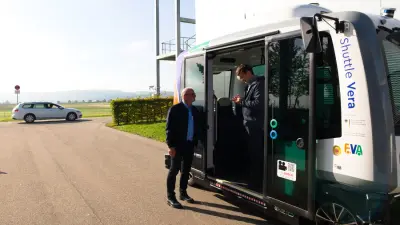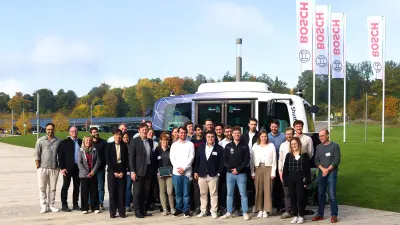Intelligent infrastructure can advance autonomous driving
At the research campus in Renningen, a team from Bosch Research and its project partners presented the results of the publicly funded project “Shuttle2X”.

How can automated shuttles travel safely and efficiently even in complex inner-city situations? Since July 2022, the partners in the publicly funded research project Shuttle2X, led by Bosch Research, have been addressing this question. On 14 October 2025, the Bosch Research project team presented their findings at the research campus in Renningen, Germany, using virtual live demonstrations with digital twins, to show how intelligent infrastructure and vehicle-to-everything communication can make automated driving both safer and more efficient.
Intelligent infrastructure as the key
“The central goal of the Shuttle2X project was to overcome the limitations of today’s on-board sensor technology while ensuring the safe interaction of all the elements involved,” says Heiko Freienstein, system expert for safety in automated driving at Bosch Research. In dense urban traffic, obstructed views or hidden objects can quickly lead to unnecessary stops or overly cautious driving. The project addressed this issue by integrating external sensors from infrastructure elements such as sensor towers, traffic lights and variable traffic signs, as well as communicating with traffic systems (V2X technology), thereby closing these information gaps.
A key challenge was to make this information reliable enough to be used for safety-critical decisions. The Bosch Research team, led by Heiko Freienstein, developed a hybrid safety concept combining vehicle sensor data with external data sources, or sending data itself. This enables smoother and safer driving.

Results and achievements
A key outcome of the project is the novel hybrid safety concept in which the vehicle and infrastructure work closely together to ensure a high level of functional safety. This approach was positively evaluated by TÜV SÜD, a technical inspection association located in Germany, following thorough testing.
The project also had an impact on an international level: the team tested current standards, such as the Collective Perception Message — which is a standardized message used by vehicles to communicate with each other and infrastructure. The team also provided important insights for the further development of these standards.
In real-world test scenarios, including those in the German cities of Karlsruhe, Bad Wimpfen and Renningen, the developed concepts ultimately proved themselves in road traffic. The project results provide pre-competitive insights for the next generation of automated vehicles. They lay the foundation for semi-automated and highly automated L2/L3 systems for both private and commercial use, as well as for subsequent research projects. They also offer important building blocks for the development of fully automated or driverless Level 4 systems.
A broadly based consortium
The Shuttle2X project was coordinated by Bosch Research. Its partners included the FZI Research Center for Information Technology, the Heilbronn University of Applied Sciences. Furthermore, the industrial and research partners Keysight, the Fraunhofer Heinrich Hertz Institute, the start-up SONAH which develops intelligent, connected infrastructure sensors and the law firm reuschlaw were also part of the publicly funded project.
The project was funded by the German Federal Ministry for Economic Affairs and Energy (BMWi), represented by the project sponsor TÜV Rheinland. Further support came from TÜV SÜD, Schwarz Mobility Solutions, and representatives of the City of Renningen and the District of Böblingen, both Germany, who contributed valuable insights from practical, safety, and user perspectives.
“I’m very grateful that we were able to bring together so many different viewpoints and areas of expertise for the project,” says Heiko Freienstein. “Our partners provided us with practical information that was extremely helpful for the test drives in the three test areas in Karlsruhe, Bad Wimpfen and Renningen.”